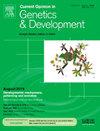How our brains are built: emerging approaches to understand human-specific features
IF 3.6
2区 生物学
Q2 CELL BIOLOGY
引用次数: 0
Abstract
Understanding what makes us uniquely human is a long-standing question permeating fields from genomics, neuroscience, and developmental biology to medicine. The discovery of human-specific genomic sequences has enabled a new understanding of the molecular features of human brain evolution. Advances in sequencing, computational, and in vitro screening approaches collectively reveal new roles of uniquely human sequences in regulating gene expression. Here, we review the landscape of human-specific loci and describe how emerging technologies are being used to understand their molecular functions and impact on brain development. We describe current challenges in the field and the potential of integrating new hypotheses and approaches to propel our understanding of the human brain.
我们的大脑是如何构建的:了解人类特有特征的新方法。
了解是什么使我们成为独特的人类是一个长期存在的问题,它贯穿于从基因组学、神经科学、发育生物学到医学的各个领域。人类特异基因组序列的发现使人们对人类大脑进化的分子特征有了新的认识。测序、计算和体外筛选方法的进步共同揭示了人类特有序列在调控基因表达方面的新作用。在此,我们回顾了人类特异性基因座的情况,并介绍了如何利用新兴技术来了解它们的分子功能及其对大脑发育的影响。我们描述了该领域目前面临的挑战,以及整合新假说和新方法以促进我们对人类大脑的了解的潜力。
本文章由计算机程序翻译,如有差异,请以英文原文为准。
求助全文
约1分钟内获得全文
求助全文
来源期刊
CiteScore
7.90
自引率
0.00%
发文量
102
审稿时长
1 months
期刊介绍:
Current Opinion in Genetics and Development aims to stimulate scientifically grounded, interdisciplinary, multi-scale debate and exchange of ideas. It contains polished, concise and timely reviews and opinions, with particular emphasis on those articles published in the past two years. In addition to describing recent trends, the authors are encouraged to give their subjective opinion of the topics discussed.
In Current Opinion in Genetics and Development we help the reader by providing in a systematic manner:
1. The views of experts on current advances in their field in a clear and readable form.
2. Evaluations of the most interesting papers, annotated by experts, from the great wealth of original publications.[...]
The subject of Genetics and Development is divided into six themed sections, each of which is reviewed once a year:
• Cancer Genomics
• Genome Architecture and Expression
• Molecular and genetic basis of disease
• Developmental mechanisms, patterning and evolution
• Cell reprogramming, regeneration and repair
• Genetics of Human Origin / Evolutionary genetics (alternate years)

 求助内容:
求助内容: 应助结果提醒方式:
应助结果提醒方式:


